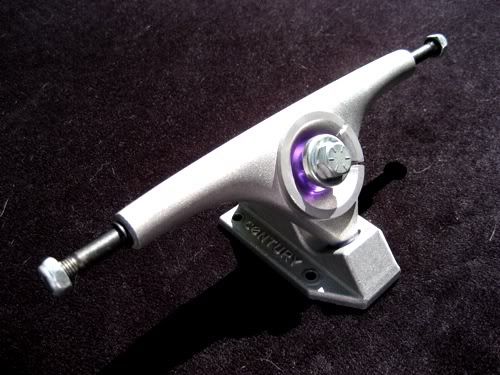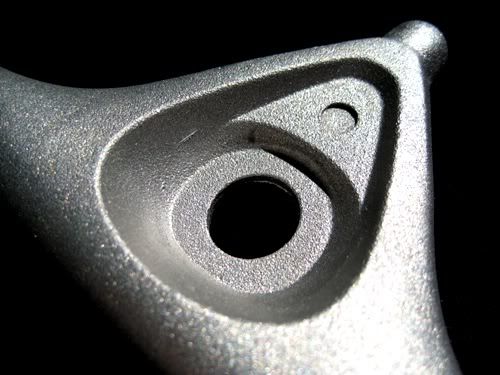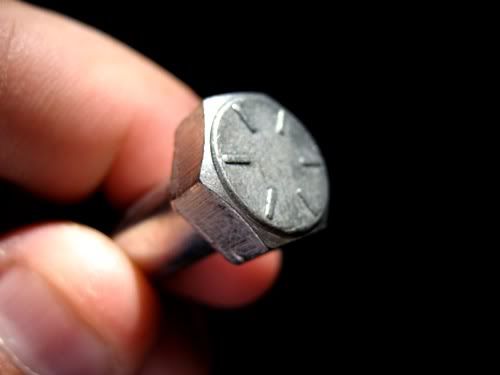

Century Trucks, like a lot of other truck brands, are a "proprietary" truck brand that belongs to a correlating board and wheel company. In this case, the "correlating" brand is Goldcoast Longboards (www.goldcoastlongboards.com). These trucks are made overseas (China), just like a lot of trucks are these days (Ace, Paris, etc).
As far as trucks go, the "China" stigma seems to be a non-issue: Chinese quality controls (as far as cast metal parts go) seem to be pretty good these days. The first impression was that they looked like they were built to take some serious abuse... their "chunky" stance, massive pivot seat, and smooth contours everywhere indicate serious strength, and long-term durability.

The overall fit and finish of the trucks is really good. That parting line could have been smoothed out a little bit more... but, we're just being picky now. All in all, everything lined up well, the castings look pretty precise, and the "raw" sandblasted finish and ground "embellishments" (the Goldcoast ring around the kingpin on the front of the truck) all looked well-done. No "real" complaints here.

The 7" Centuries arrived mounted on a Goldcoast "Modra" complete. We're never satisfied to test "only" what the manus hand us, so component swap-outs are super-common around the office. Putting trucks onto several different boards, for example, gives a much more "rounded" picture of how these things work in a variety of real-world applications. Besides: The Centuries are clearly available at the Goldcoast website as a stand-alone purchase ($45.00). Surely, these will end up on a lot more than just Goldcoast completes...!
For most of the past three months or so, we've had the Centuries set up on our resident "test hack", a well-used Loaded Pin (Flex:1). I actually liked the Centuries set up on this board much better than the Modra they originally came on... although "why" that's the case, is kinda beyond me. Just something about it, man...! It works...!

If you get the Centuries on a complete setup, they'll more than likely come with these specially-shaped-to-match wedge pads. Not quite "hard", and not quite "soft", they feel like they're made out of a dense rubber composite (as opposed to a more "standardized" polyurethane). They are really well executed, but the only "gripe" we had was that a corresponding "de-wedge" pad would have been really bonus. Especially on the Loaded Pin/O'tang/Century combo, where the flex of the deck further exacerbates the "wedge" effect. A de-wedge option would give better rear-truck traction for LDP apps, and would differentiate the geometry enough to practically eliminate wobbles.
That said, the trucks are a great blend of turn-ability, and stability. Wobs and squirrels were extremely rare, yet the board was happily "carvy" at the same time. All in all, a pretty impressive performance.
That might explain why I liked them the best on the Loaded/O'tang combo: We could squeeze the most performance out of 'em mounted up on on that Pin, and see what they're really made of...

The "exploded" view of the truck. Note that the bushings are "standard" [short] conicals on top, and barrels on the bottom. Replacement bushings should be a snap to find... unlike something like a Bennett, which uses highly specialized barrels on the top and bottom. Khiros, Bones Hardcores, Kruxes, aftermarket Independents, whatever... they'll all work, and work well.

However, nobody in the office (myself, included) ever bothered to swap out the original bushings. Because, they're really pretty good. Way better than a stock Indy bushing, but not quite as good as a stock Ace or Krux bushing (which are super-snappy and responsive). The duro on the bushings is 85a, and they're made out of we would describe as a "pretty bouncy", medium-rebound urethane.
I thought that was a nice and thoughtful touch. Being an "Indy Guy", I can totally appreciate good bushings...

The backs of the castings point to a possible die-casting process (not unlike old Gullwings). Clean, intricate details and close tolerances are possible with die casting... so I'm not surprised that they'd opt to use it on a longboard truck, where holding precision tolerances is pretty important. Especially if high speeds are involved... then, it's critical.

This photo better illustrates the benefits of die casting. Note the minimal "flash" in the through-hole, and the crisp angles and flats of the casting.
Take a look at that ding, just to the upper left of the through-hole, halfway up the bushing seat. One thing that you'll want to know is that, snugged down, the bottom washer has a tendency to stop the truck's turn... effectively "locking out" the truck. The washer hitting the hangar is what caused that ding. On one hand, it's a handy way of eliminating wheelbite. On the other hand, on a cutaway deck... where far deeper turns are possible... you might not like this "feature" at all.

See how close to the hangar that bottom washer is...? Yeah: That's what we're talking about in the above photo. A flatter bottom washer, or a cored bottom bushing (where no washer is required) would allow for much, much deeper turns than the "stock" washers will ever allow.
You can also see that when the truck is set at a "medium" tightness... not wobbly, but not clamped down... the geometry between the hangar and the base is a solid 90 degrees. Everything goes together well, and the result is straightforward turn-ability with a minimum of surprises.

Grade 8 kingpins... good call. Another sign of a thoughtfully-designed truck that uses quality components all the way through.
We did check to see how the truck went together, with the hangar "flipped". The short answer was, "it didn't". Not well, by any means. The verdict? This truck is probably not intended to be flipped...

... because, the raised embossing around the bushing seat was a bit of a problem...

... and clearly, the bushings wouldn't have seated well, anyway...

... and lastly, the geometry was just all kinds of screwed up, with the hangars turned around. To be honest: The trucks work just great, right out of the box. I don't see a need to "flip" these at all. But, if that's your bag? Get something else.

The only "real problem" that we ever had with these trucks, was with the hangar-baseplate interface... aka, "pivot cups". At first, the hangars felt sticky in the cups. The solution? A drop of lube on the pivot. Problem solved.
The problem was more than likely caused by...

... the sandblasted "texture" on the pivot. Once we gave 'em The Lube, everything was just dandy. It also helped the pivot cups stand up to the abrasive nature of the pivot, minimizing wear and tear.
So, what's the final verdict? Well, at the $45-per-pair pricepoint, they're among the least expensive cantilevered trucks on the market... if not, the least expensive. Aesthetically and performance-wise, I thought that they were quite good... surely better than many of their contemporaries (Gullwing Alpines and Randals come to mind). With a bushing upgrade and a bottom-washer swap-out, they might be even better still. But really, the best thing that Goldcoast could probably do would be to offer some more specially-shaped riser-pad options. It would be a very cost-effective means of squeezing the very best performance out of what is really, a pretty well-designed and capable truck system.
In short: We liked 'em a lot. Try some for yourself, and let us know what you think.
